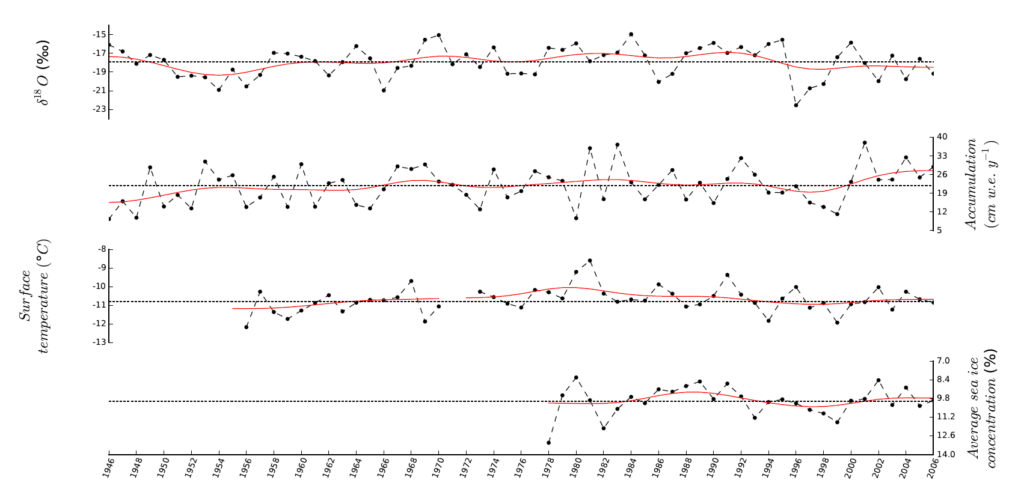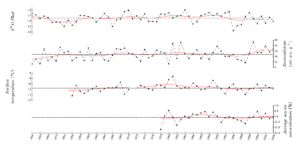A 22.4 m-long shallow firn core was extracted during the 2006/2007 field season from coastal Adélie Land. Annual layer counting based on sub-annual analyses of δ18O and major chemical components was combined with 5 reference years associated with nuclear tests and non-retreat of summer sea ice to build the initial ice core chronology (1946-2006), stressing uncertain counting for 8 years. We focus here on the resulting δ18O and accumulation records. With an average value of 21.8±6.9 cm w.e. y-1, local accumulation shows multi-decadal variations peaking in the 1980s, but no long-term trend. Similar results are obtained for δ18O, also characterized by a remarkably low and variable amplitude of the seasonal cycle. The ice core records are compared with regional records: temperature, stake area accumulation measurements, and variations in sea ice extent, and outputs from two models nudged to ERA atmospheric reanalyses: the high resolution atmospheric general circulation model (AGCM) including stable water isotopes ECHAM5-wiso and the regional atmospheric model MAR. A significant linear correlation is identified between decadal variations in δ18O and regional temperature. No significant relationship appears with regional sea-ice extent. A weak and significant correlation appears with Dumont d’Urville wind speed, increasing after 1979. The model-data comparison highlights the inadequacy of ECHAM5-wiso simulations prior to 1979, possibly due to the lack of data assimilation to constrain atmospheric reanalyses. Systematic biases are identified in the ECHAM5-wiso simulation, such as an over-estimation of the mean accumulation rate and its inter-annual variability, a strong cold bias, and an under-estimation of the mean δ18O value and its inter-annual variability. As a result, relationships between simulated δ18O and temperature are weaker than observed. Such systematic precipitation and temperature biases are not displayed by MAR, suggesting that the model resolution plays a key role
along the Antarctic ice sheet coastal topography. Inter-annual variations in ECHAM5-wiso temperature and precipitation accurately capture signals from meteorological data and stake observations, and are used to refine the initial ice core chronology within 2 years. After this adjustment, remarkable positive (negative) δ18O anomalies are identified in the ice core record and the ECHAM5-wiso simulation, respectively in 1986 and 2002 (1998-99). Despite uncertainties associated with post-deposition processes and signal-to-noise issues in one single coastal ice core record, we conclude that the S1C1 core can correctly capture major annual anomalies in δ18O as well as multi-decadal variations. These findings highlight the importance of improving the network of coastal high resolution ice core records, and stress the skills and limitations of atmospheric models for accumulation and δ18O in coastal Antarctic areas, particularly important for the overall East Antarctic ice sheet mass balance.
Authors : S. Goursaud, V. Masson-Delmotte, V. Favier, S. Preunkert, M. Fily, H. Gallée, et al
Reference : The Cryosphere, 11, 343-362, 2017, doi.org/10.5194/tc-11-343-2017



